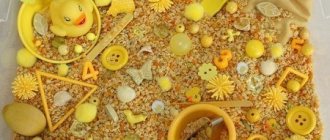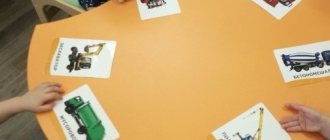Abstract of the educational activity "Journey into the forest"
Ministry of Education and Science of the Samara Region
State autonomous educational institution of additional professional education (advanced training) for specialists
Samara Regional Institute of Advanced Studies
and retraining of education workers
Final work
on the advanced training course in IOC
«Communicative activities of preschool children, taking into account
Federal State Educational Standard for Preschool Education»
on the topic of:
«Planning direct educational activities
as a program element that provides requirements
educational field "Speech development"
"Journey to the Enchanted Forest"
training time: (02/15 – 02/20/2015)
Performed:
Badun Vera Borisovna
GBOU secondary school No. 19 structural unit “kindergarten “Korablik””, G.O. Novokuibyshevsk, teacher.
Samara, 2015
Theme "Journey to the Enchanted Forest"
Age category: middle preschool age.
Integration of educational areas: cognitive development, socio-communicative development.
Tasks:
Speech development, Cognitive development
- activate the vocabulary of objects, signs, actions on the topic “Birds”, “Spring”, “Flowers”;
- Strengthen the skill of agreeing nouns with adjectives, ,
- Develop the ability to express your thoughts in complete sentences
- Develop dialogue skills
- Strengthen the ability to engage in verbal interaction and participate in a collective conversation.
- Enrich your vocabulary with adjectives and verbs.
- . Introduce the concepts of “Bird wedge”, “Drips”, “Ice drift”, “primrose”
- Form an idea of the signs of early spring
- Develop clarity of diction and the ability to correlate speech with movements Social and communicative:
- Cultivate a friendly, responsive attitude towards others;
- .Develop the ability to act in a group;
- Show active participation in the character's fate
- Strengthen the ability to engage in verbal interaction and participate in a collective conversation.
- Strengthen the ability to express your thoughts in complete phrases
- Maintain interest in the activity
Methods and techniques:
Practical: creating a problem situation, a surprise moment, games, application, active children's activities, comparison.
Visual: the use of visual aids, decorations, musical accompaniment, display, demonstration of illustrative aids, presentations.
Verbal: explanations, instructions, assessment of children's activities, use of artistic words, encouragement, explanation, leading to a conclusion.
Types of children's activities: play, motor, communicative, productive, cognitive - research, labor, musical - artistic.
Materials and equipment: multimedia projector, interactive whiteboard. Pano-sun made of velvet paper without rays and yellow counting sticks for creating rays; a mosaic silhouette of the sun without rays and a yellow mosaic to create rays, a pano-sun with short rays and yellow clothespins (to create rays), a pano of the sun made using the “Plasticineography” technique and peas to create rays. presentation of a lesson plan with interactive games, blue fabric for a stream, foam ice floes, masks of migratory birds for each child, an envelope with a letter from the Old Forest Man, a treat for each child (birch sap, liver nuts), cards with images of children's clothes for a boy and girls (winter, spring) - the same number of cards for 2 teams. Old man forester costume.
| Children's activities | Forms and methods of organizing joint activities |
| Motor | outdoor games, play exercises, motor breaks, physical exercises |
| Gaming | Game situations, games with rules (didactic, active), creative games (story-based, role-playing, constructive) games |
| Cognitive and research | Observations, excursions, problem solving, modeling. |
| Communicative | Conversations, speech situations, creative retellings, composing and guessing riddles, word games, board-printed games with rules, story games, situational conversations, speech training, questions. |
| Musical | Listening, performing, musical and didactic games, outdoor games with musical accompaniment. |
| Fine | Application. |
| Perception (fiction and folklore) | Introduction and discussion of the Russian folk proverb “Good always triumphs over evil.” |
| Construction | constructive games. |
| Basic household work (indoors and outdoors) — Self-service | Instructions (individual and subgroup), joint (collective) actions. |
Logic of educational activities.
| Activities of the teacher | Pupils' activities | Expected results |
| 1. Introductory part. He comes into the group dressed as an old forest man. Greets the children and finds out where he ended up | They report that Lesovichok ended up in the “Ship” kindergarten, in the sun group. | Able to engage in verbal interaction, participates in group conversations, and has a positive attitude towards the world around him |
| “Spring has not come to the forest” Reports that spring does not rush into the forest. Crying... | They feel sorry for the old forest man. | Shows sympathy for the hero, knows how to determine the emotional state |
| "The forest has been enchanted." Offers to find out what happened to the forest? | They express their opinions about who bewitched the forest. If they find it difficult, ask the guests. | Able to express opinions in complete phrases, master the skill of conducting dialogue, and have developed verbal and logical thinking |
Divides the children into 2 teams (1 team - boys, 2 team - girls), gives each team cards. | Children are divided into 2 teams, take cards that depict men's and women's clothing intended for different seasons. Team 1 chooses winter clothes for girls, team 2 - for boys. Then they express why they made this choice. | Can classify, has developed verbal and logical thinking, can engage in verbal interaction, interacts with peers |
Invites the children to walk along the path. to get into the forest. (To get into the forest, you need to walk along this slippery path, and so that no one falls, stand behind each other and put your hands on the shoulders of the comrade who is standing in front of you.) Draws attention to the (sad) sun that appears on the interactive board. | Children take hold of each other’s shoulders and walk along a specially laid out path, saying the simple saying: Ma-ma-ma Snowy winter in the forest Egg-eg-eg Everything was covered with white snow But but but It's very cold in the forest | Has developed general motor skills, knows how to interact in a group of children, knows how to correlate speech and movement, has clear and intelligible diction |
He offers to wake up the sun and shine some rays on him.
8. A bright spring sun appears on the screen and asks you to name what it should be like in spring. | Children break into pairs and make rays of sunshine. 1 pair of children lays out the sun from sticks and a circle on velvet paper; 2 pairs of children lay out a bean sun on a plasticine base; 3 pairs of children collect the sun from clothespins. Pair 4 lays out rays from the mosaic. (Calm music sounds) Select definition words for the sun: affectionate, cheerful, warm, joyful, radiant, bright | Able to work in groups, has developed fine motor skills, has developed visual perception, and is able to perceive objects holistically Has a rich vocabulary of adjectives. Able to select definition words for a subject |
Invites all children to look at the stream and determine why it is silent. And offers to play an interactive game. | They notice that the stream is lined with ice floes, which prevent the stream from flowing. Please note that there are some encrypted pictures on the ice floes. Children take turns removing ice floes, naming the signs of spring depicted on them. — The sun shines brighter and warms warmer. - Snow is melting. It becomes loose and dirty. - Streams are flowing. — Thawed patches appear on the ground. Snowdrops bloom in thawed areas. — Drops are dripping (the icicles are melting). — Buds appear on the trees, and the first leaves emerge from them. — Birds fly from the south. They chirp, look for food, build nests. — Animals wake up after winter. They give birth to babies. They disenchant the stream. Listen to the murmur of the stream. | He has developed verbal and logical thinking, knows how to express thoughts in complete phrases, knows how to interact with peers, has formed ideas about spring as a time of year, and knows the signs of spring. |
Includes a slide where an owl appears on the screen saying that the birds do not remember which of them are wintering and which are migratory. The owl asks for help: “Please help the birds resolve the dispute.” In case of difficulty, the teacher helps the children name and classify the birds. | Birds are examined using an interactive board. At the request of the teacher, the child whose name was named names the bird that was indicated to him and classifies it as “wintering” or “migratory” Resolving a bird dispute. | Able to classify objects according to certain criteria, able to work in a group. Able to express thoughts in complete phrases, has a developed vocabulary on the topic “Birds” |
He suggests building a bird wedge. Helps children, in case of difficulties, line up in a bird wedge. (Guys! Do you know that even birds have their own certain rules, When do birds fly? There are various difficulties along the way And so as not to lose anyone along the way The leader of the pack must gather the team into a wedge. Will you help the birds form a wedge?
(Guys! Is it a beautiful clearing? Do you like it? What’s wrong with it?) Includes interactive game: "Flower fairies in the meadow" (We have seedlings of ready-made spring primroses from our flower garden, but it will be difficult for us to plant them alone. You guys, help and name the names of the flowers. If you remember all the names of the flowers, the clearing will come to life. Invite the children to name the primroses and decorate the clearing with them. | Children, using a counting rhyme, choose the leader of the flock and form a bird wedge. They look at the clearing and notice that nothing grows on it at all. Looking at a basket of primroses. They remember the names of the flowers and plant them in the clearing. | Knows how to negotiate, knows how to engage in verbal interaction, interacts with peers, has an understanding of the concept of “Bird wedge” and knows how birds build it Has a developed vocabulary on the topic “Flowers”, knows how to classify objects, knows how to interact in a children’s group, has an understanding of primroses |
| 13 Finger gymnastics “The flower is waiting for guests” The flower in the flowerbed grows and blooms, basking in the sun, waiting for guests. . A bug came running to him to swing, The breeze sways and sways. A moth has flown in to drink the sweet juice, The breeze sways and sways it. "The flower is swinging" A bee flew to a flower for honey, She swayed a little and collected the honey. But then the bee and the moth flew away, The bug ran away, and the flower remained. Basking in the sun, he will stand, And the sun will set, our flower will sleep.
Baba Yaga talks about how she enchanted the forest, but she no longer wants to be evil, but wants to do good deeds. The old forest man offers to name what kind of good deeds Baba Yaga can do | Sing and perform finger gymnastics: One of the hands is a “flower”. Stands on the table, leaning on his elbow The fingers of the second hand run along the table, “the bug crawls into the cup” (palm). The hand - the flower is swinging. Second hand - the bug “sits” in the “cup” They move the fingers of the other hand in the air and place them in a “cup” They move the fingers of the second hand in the air and lower them into the “cup” again. They swing the “flower” and stroke the palm with the other hand (collect honey) They move the fingers of the other hand in the air (the bee and the moth fly away) The fingers of the second hand “run away” from the flower (bug) Rotate the brush (flower cup) They clench their fist (the flower is closed They remember and list in a circle the good deeds that they themselves have done. They forgive Baba Yaga for her bad deed. Become familiar with the proverb “Good always triumphs over evil.” They thank Baba Yaga for the gift and say goodbye to her. | Has developed fine motor skills, correlates finger movements and song lyrics. Interacts in a group of children, knows how to express thoughts in complete phrases, and shows sympathy for the hero. Understands the meaning of the proverb “Good conquers evil.” |
| 15."Homecoming" Offers to remember the address of the kindergarten. Invites children to consolidate their strength together by holding hands. While the children are “flying” on the carpet, he quietly takes off his forester costume. 16. Summarizing. Encourages children to tell stories about where they have been and to draw conclusions. Reads a telegram that came from the forest from the forester. Shows the treats that were sent to the children from the forest. Introduces children to the new concept of “Birch Sap”. talks about the benefits of birch sap. (You know that birch sap is a real forest product that is extracted from a tree... birch. It is very healthy, it contains many vitamins to improve immunity, and most importantly it is a very good remedy for caries! If you drink birch sap, then you and your teeth will be healthy.) | They give the address and, holding hands, “fly” home on a magic carpet over the forest. Watch the video “Spring in the Forest”. They remember what they saw and what good deeds they did. They come to the conclusion that they need to help each other and, if necessary, be able to ask for help. Get acquainted with the new concept of “Birch sap” and its benefits. Taste the juice. | He knows how to interact in a group of children, knows the address of the kindergarten, and has developed attention and memory. Has artistic, aesthetic and cognitive-research perception Knows how to engage in verbal interaction, participates in a collective conversation, has a positive attitude towards the world around him. Possesses positive health-saving skills (eat healthy food). |



